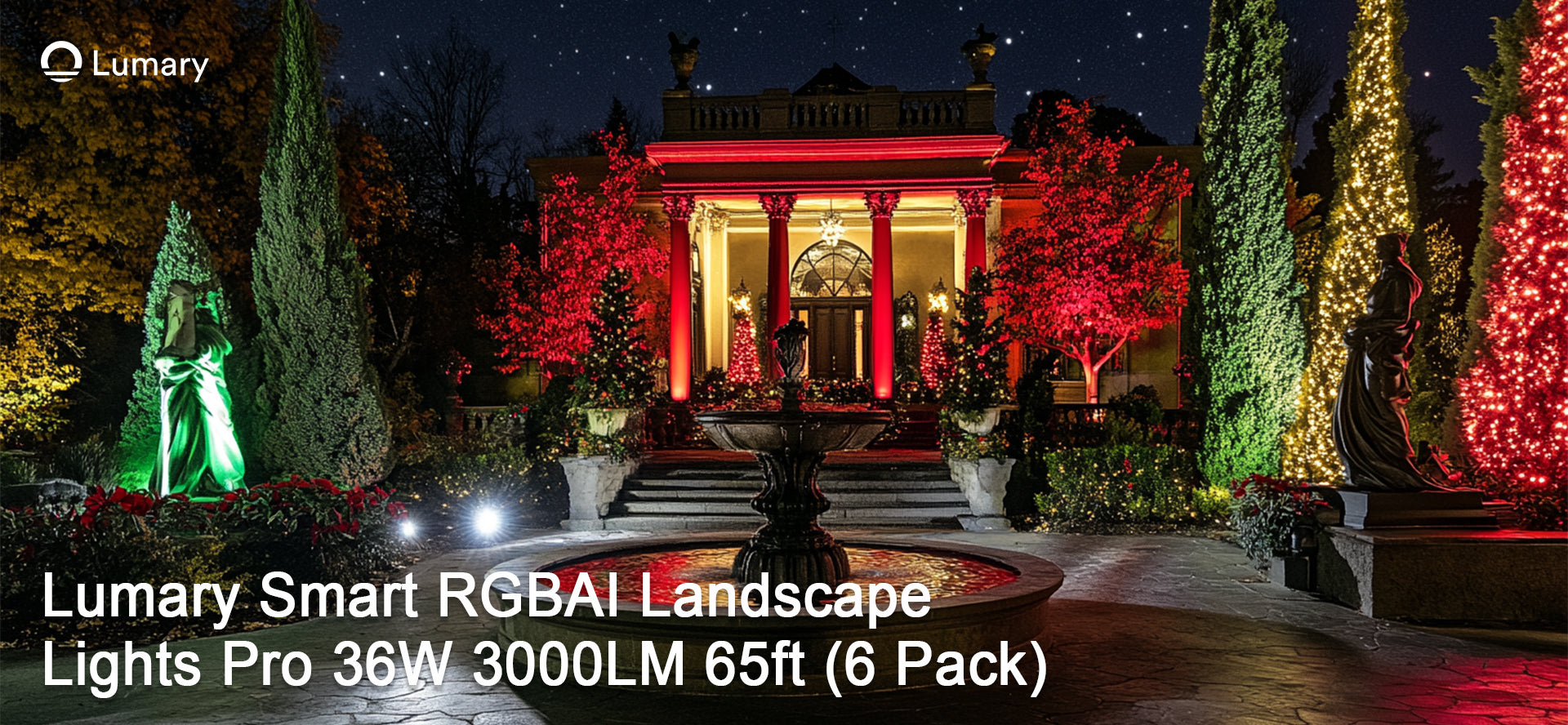Imagine transforming your outdoor space into a vibrant, colorful haven with outdoor colour changing LED lights. These innovative lights let you create the perfect ambiance for any occasion. Whether you're hosting a party or relaxing under the stars, outdoor colour changing LED lights add a magical touch. With the right steps, you can easily install them and enjoy the glow.

Key Takeaways
-
Color-changing LED lights make outdoor areas fun by letting you pick colors and brightness for any event.
-
Get tools like a screwdriver, drill, and measuring tape ready before you start to make the setup easy.
-
Clean and check your lights often to keep them working and looking nice.
Understanding Outdoor Color-Changing LED Lights
What Are Color-Changing LED Lights
Color-changing LED lights are a modern lighting solution that lets you adjust the color and brightness of your lights to suit any mood or occasion. These lights use advanced LED technology to produce a wide range of colors, from warm amber tones to cool daylight hues. You can control them through apps, remotes, or even voice commands, making them incredibly convenient.
For outdoor spaces, color-changing lights are a game-changer. They can illuminate your garden, pathways, or patio with vibrant colors, creating a stunning visual effect. Whether you're hosting a party or enjoying a quiet evening, these lights let you customize your outdoor lighting to match the vibe.
Benefits of RGB Color-Changing LED Strip Lights
RGB color-changing LED strip lights are one of the most versatile options for outdoor lighting. They combine red, green, and blue LEDs to create millions of color combinations. This flexibility allows you to design unique lighting effects for your outdoor space.
One major benefit is their ability to enhance your landscape lighting. You can use them to highlight trees, statues, or architectural features, adding depth and character to your yard. These lights are also energy-efficient, so you can enjoy beautiful lighting without worrying about high electricity bills.
Another advantage is their durability. Many outdoor color-changing LED lights, like the Lumary Smart RGBAI Landscape Lights Pro, are waterproof and built to withstand harsh weather conditions. This makes them perfect for year-round use. Plus, features like music sync and timer scheduling make them ideal for parties and gatherings.
With RGB color-changing LED strip lights, you can transform your outdoor space into a vibrant, inviting area that stands out.
Tools and Materials Needed
Essential Tools for Installation
Before you dive into your DIY project, gather the right tools to make the process smooth and hassle-free. Here’s what you’ll need:
-
Screwdriver: A basic tool for securing mounting brackets or screws.
-
Drill: Useful for creating holes if you’re attaching lights to walls or other surfaces.
-
Measuring Tape: Helps you measure the exact length of the area where you’ll install the lights.
-
Wire Strippers: Necessary for preparing wires during the installation process.
-
Ladder: If you’re working on elevated areas, a sturdy ladder ensures safety.
-
Gloves: Protect your hands while handling wires or sharp tools.
Having these tools ready will save you time and effort. Plus, it ensures you can focus on creating the perfect outdoor lighting setup.
Components for Outdoor LED Installation
Now that you’ve got your tools, let’s talk about the components you’ll need. These items are essential for setting up your outdoor color-changing LED lights:
-
LED Strip Light Power Supply: This powers your lights and ensures they function properly. Make sure it’s compatible with your chosen lights.
-
RGB LED Strips or Spotlights: For this guide, we recommend the Lumary Smart RGBAI Landscape Lights Pro. They’re durable, waterproof, and perfect for outdoor use.
-
Connectors and Extension Cables: These help you link multiple strips or extend the reach of your lights.
-
Mounting Clips or Adhesive Tape: Use these to secure the lights in place.
-
Smart Controller or Remote: This allows you to adjust colors, brightness, and other settings.
-
Weatherproof Enclosures: Protect the power supply and connectors from rain or snow.

With these components, you’re ready to bring your outdoor lighting vision to life. Whether you’re highlighting a pathway or creating a festive display, these materials will help you achieve a professional-looking installation.
Tip: Double-check that all components are rated for outdoor use to ensure durability and safety.
Step-by-Step Instructions to Install Outdoor Color-Changing LED Lights
Preparing the Installation Area
Before you start, take a moment to prepare your outdoor space. This step ensures your landscape lighting setup goes smoothly. Begin by identifying the areas you want to illuminate. Think about pathways, trees, or garden features that could benefit from vibrant lighting.
Once you’ve chosen the spots, clean the surfaces where you’ll install the lights. Remove dirt, debris, or moisture to help the adhesive or mounting clips stick properly. If you’re working on uneven ground, level it out to keep the lights secure. Use a measuring tape to mark the exact placement of each light. This helps you avoid mistakes and ensures a professional-looking result.
Tip: Plan your layout to minimize the need for extension cables. This keeps your setup neat and reduces tripping hazards.
Connecting RGB Color-Changing LED Strip Lights
Now it’s time to connect your color-changing lights. Start by unrolling the LED strips or positioning the spotlights, like the Lumary Smart RGBAI Landscape Lights Pro, along your marked areas. Attach the lights using mounting clips or adhesive tape.
Next, connect the lights to the power supply. Use connectors to link multiple strips if needed. Make sure all connections are secure and weatherproof. If your lights come with a smart controller, pair it with your smartphone or remote. This lets you adjust the colors, brightness, and other settings with ease.
Note: Double-check that the power supply and connectors are rated for outdoor use to ensure safety and durability.
Testing and Adjusting the Setup
Before you call it a day, test your outdoor color-changing lights. Plug them in and turn them on. Use the app or remote to cycle through the colors and brightness levels. Check for any dim spots or areas where the lights aren’t working.
If something looks off, adjust the placement or connections. For example, reposition the lights to highlight specific features like trees or pathways. Once everything looks perfect, secure the setup with additional clips or tape if needed.
Pro Tip: Experiment with different color combinations to create the perfect ambiance for your outdoor lighting.
By following these step-by-step instructions, you’ll have a stunning landscape lighting setup that transforms your outdoor space into a vibrant, inviting area.
Troubleshooting Common Issues
Fixing Power or Connectivity Problems
If your lights don’t turn on or seem unresponsive, don’t worry. Start by checking the power supply. Ensure it’s securely plugged into an outlet and that the outlet is functioning. If you’re using an extension cord, confirm it’s in good condition.
Next, inspect the connections between the power supply and the color-changing lights. Loose or improperly connected wires can cause issues. Reconnect them firmly and make sure they’re weatherproof. If your lights use a smart controller, verify that it’s paired correctly with your app or remote. Sometimes, resetting the controller can resolve connectivity problems.
Tip: If you’re still having trouble, try plugging the lights into a different outlet to rule out electrical issues.
Resolving Color-Changing Malfunctions
Are your lights stuck on one color or not displaying the right hues? This can happen if the controller or app settings are misconfigured. Open the app and check the color settings. Adjust them to see if the issue resolves.
If the problem persists, inspect the LED strips or spotlights for damage. A damaged section can disrupt the color-changing function. Replace any faulty components to restore proper operation. Also, ensure the connectors are securely attached, as loose connections can interfere with the lights’ performance.
Pro Tip: Update your app or firmware regularly to avoid glitches with your color-changing lights.
Addressing Weather-Related Issues
Outdoor installations face challenges like rain, snow, or extreme temperatures. If your outdoor color-changing LED lights stop working after bad weather, check for water damage. Look at the power supply and connectors. Dry them thoroughly and replace any damaged parts.
For long-term protection, use weatherproof enclosures for the power supply and connectors. These keep moisture out and extend the lifespan of your lights. If you live in an area with heavy snowfall, clear the snow around the lights to prevent overheating.
Note: Always choose lights with a high waterproof rating, like IP65, to ensure they can handle outdoor conditions.
By addressing these common issues, you’ll keep your outdoor lighting setup running smoothly and enjoy vibrant displays year-round.
Maintenance Tips for Outdoor Color-Changing LED Lights
Cleaning and Protecting the Lights
Keeping your outdoor color-changing lights clean is essential for maintaining their brightness and performance. Dirt, dust, and debris can accumulate over time, especially in outdoor spaces. Use a soft, damp cloth to wipe down the lights regularly. For stubborn grime, mix a mild soap with water and gently scrub the surface. Avoid using harsh chemicals, as they can damage the finish or waterproof coating.
To protect your lights from the elements, consider adding weatherproof enclosures for the power supply and connectors. These enclosures shield the components from rain, snow, and extreme temperatures. If your lights are near plants or trees, trim any overhanging branches to prevent scratches or damage. Regular cleaning and protection will keep your outdoor lighting looking great year-round.
Checking for Damage or Wear
Inspect your lights periodically to catch any signs of damage or wear. Look for frayed wires, loose connections, or cracks in the casing. These issues can affect the performance of your outdoor lighting and may even pose safety risks. If you notice any problems, address them immediately to prevent further damage.
Pay close attention to the mounting clips or adhesive tape holding the lights in place. Over time, these can weaken due to weather exposure. Replace them if they no longer hold securely. Regular checks ensure your lights stay in top condition and continue to enhance your outdoor space.
Replacing or Upgrading Components
Sometimes, parts of your outdoor color-changing lights may need replacing. If a section of the lights stops working, swap it out with a compatible replacement. Always choose components rated for outdoor use to ensure durability. For example, if you’re using the Lumary Smart RGBAI Landscape Lights Pro, look for parts designed specifically for this model.
Upgrading your setup is another way to keep your outdoor lighting fresh and exciting. Consider adding new features like music sync or additional lights to expand your display. Replacing or upgrading components helps you maintain a vibrant and functional lighting system that adapts to your needs.
Tip: Keep spare parts on hand for quick fixes and upgrades.
Installing outdoor colour changing LED lights doesn’t have to be complicated. With the right tools and steps, you can create a vibrant outdoor space that stands out. These lights let you customize your ambiance for any occasion. Why wait? Start your installation today and enjoy a colorful, inviting atmosphere year-round.
FAQ
How much do color changing lights cost?
The cost varies based on features and quality. For example, premium options like Lumary Smart RGBAI Landscape Lights Pro typically range from $100 to $200.
Can I install color-changing LED lights without professional help?
Yes, you can! With the right tools and this guide, installing outdoor color-changing LED lights is a simple DIY project.
Are outdoor color-changing LED lights safe in bad weather?
Yes, most outdoor LED lights, like Lumary Smart RGBAI Landscape Lights Pro, are waterproof and designed to handle rain, snow, and extreme temperatures.

















